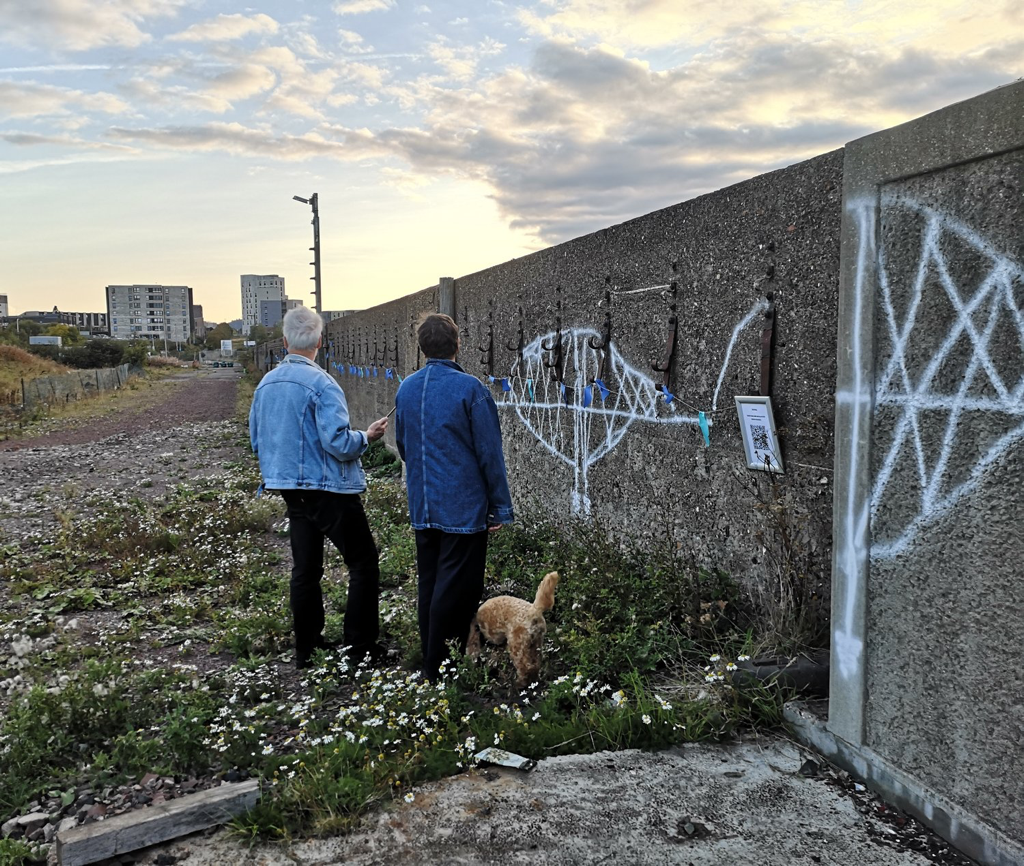The Wall is a soundwalk by Tamsin Granger, in which she questions gentrification and appropriation in the name of regeneration, which erases external reminders of the past.
Tamsin’s work is one of the shortlisted pieces in the Sound Walk September Awards 2022. Here, she discusses the context of her work.
The Wall is a site-specific, guerrilla soundwalk along the Western Breakwater of Granton Harbour in Edinburgh. Using a QR code, the participant has access to a Soundcloud recording, and while walking the 3100 feet (nearly three fifths of a mile), might also view the visual art aspect of the installation.
The Site
The harbour is a complex place. Built around 1849, it has many layers of social and economic history. Memories swim in its waters, swirl around in its air, and have been trodden into the land. For many people who live in its vicinity, it is part of their heritage and a vital connection to their ancestors. It is currently being developed and, as part of this, the names of its byways have been changed.
Research
Over an extended period of ten plus years, I have been learning about and researching this former bustling and busy international port which has a special connection to the Forth Bridges.
Most information was gleaned from local people, including my neighbour who was a little girl when the ships arrived bringing Esparto grass for the paper-making industry nearly 100 years ago. I have walked the area over and over again, listening, looking, smelling, touching and tasting. In addition, some information came from the Granton History Hub (live and online), and I have referenced and cross-referenced official sources such as documents from Edinburgh City Council Planning Department.
Unfortunately, Marina Developments, who stumped up £5 million investment for the transformation, have repeatedly ignored my invitations to dialogue.
The word on the street is that the council tried to renege on the permission they gave before the last economic recession (there has been little development since then), to no avail. Perhaps they, too, have fallen foul of a system which allows businesses to destroy local and historical infrastructure without hearing the real needs of the people who live(d) and work(ed) in the area, and replace it with berths for super yachts, a five-star hotel, and penthouses for the wealthy.
Who or What is The Wall?
The wall stands on the breakwater, and as I became more familiar with it, it began to speak to me.
It has a rather high and mighty, haughty manner with overtones of the bossy despot; as if it is deserving of attention due to its bulk and stature. It sees further than us, boasts, and shouts orders, repeatedly reminding the listeners that all power lies with it and not them. Underlying this attitude is the message that the way we are spoken to by ‘the authorities’, and the information we are fed about what happens and why, though it concerns us and our way of life, is that ‘they’ know better than we do about what we need and want, indeed that what they are giving us, is exactly that.
Made of natural elements, it was fashioned by the hand of Man, as were other famous walls like the Berlin and Belfast ones with which it compares itself, and it is so tall that you cannot see over it. Consequently, it observes everything and knows the area very well, it even makes jokes about the new place-names that the harbour has been given.
Recounting stories it has overheard through the ages, most of what it witnessed has now been destroyed, disappearing under the weight of so-called urban regeneration, and apparently in response to the need for increased housing stock, though possibly as more of an investment opportunity.
Despite all this, it has a tendency to share, tries to be entertaining, poses a riddle, tells the visitor where to walk and what to do, and even forgets itself and becomes a little playful at times.
In 1855, the nearby quarry was inundated, the sea filling the five acre / 80ft deep basin in only five minutes. Environmental use, therefore, in the context of the encroaching tide and as a result of climate change, is necessary, and the wall considers itself very important as a result.
Visual Aspect
The visual art aspect of the work resembles graffiti, referencing the iconic rail bridge which cannot be seen from the walk. In order to attract attention from a distance, and also to connect with the No Birds Land sound walk nearby, it has aquamarine and turquoise bunting looped over the wall’s rusty cable brackets.
Bunting was first used by the Royal Navy in the 17th century, and the harbour was a naval base between 1914-19 and again during WW2.
Now
The Wall is an unfunded sound walk, and pedestrian access to it is consistently being blocked by the developers. Sometimes dog walkers and others break through, and their feedback about the work has been encouraging, but making the walk is becoming harder to do as the erected fences rise higher and higher and the steel increasingly reinforced.
When I meet Granton Harbour residents now, they have things to say about the state of the area and what it is like to live there. Since places have been renamed and landmarks removed, the older people have shown confusion about what is where, they cannot get their bearings. The Wall is putting some of that into words, giving some of those voices an outlet.
I am pleased to be playing a part in that, and honoured that Sound Walk September have recognized the work.
This text is the tenth in a series of the artists shortlisted for the Sound Walk September 2022 Awards talking about their work.


